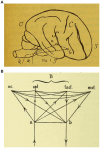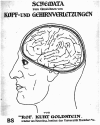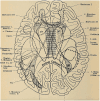Assessing Kurt Goldstein's lasting influence in the neuropsychology of language versus his use of aphasic symptoms as diagnostic insights into brain injuries
- PMID: 39246308
- PMCID: PMC11378735
- DOI: 10.3389/fpsyg.2024.1356824
Assessing Kurt Goldstein's lasting influence in the neuropsychology of language versus his use of aphasic symptoms as diagnostic insights into brain injuries
Abstract
In the history of the neurological relationship between human behavior and brain function in Europe and North America, various perspectives on brain localization and holistic functioning have been addressed. One of the founding figures of modern neuropsychology, Professor Hans-Lukas Teuber (1916-1977) of the Massachusetts Institute of Technology, reminded the scholarly community of its negligence of preceding traditions in day-to-day research endeavors. Teuber particularly emphasized that during the development of the aphasiology field (1950s-1960s) even major figures, such as the German-American neurologist Kurt Goldstein (1878-1965), had been neglected in the scientific community's collective memory. This happened despite Goldstein's contributions to cortical blindness, vicarious brain functioning, and neurorehabilitation. The outcome of the debates regarding the neurology of language had to be incompletely relearned in later decades. Neuropsychological concerns regarding the relationship between cortical localizationism and functional holism have made recourse to Goldstein's work necessary for reviving historical answers for current conundrums. It is therefore opportune to review Goldstein's work in the light of the history of aphasiology. Contemporary scholarship has once more drawn research attention to the works of Goldstein along with Norman Geschwind (1926-1984) and his pupils. It has also resurrected the underlying research of Carl Wernicke (1848-1905). This review article explores deep and lasting questions regarding the positioning of Goldstein's holism among the contemporary holistic perspectives. It does so by firstly discussing Wernicke's traditional model of distributed localizationism. Secondly, it describes Goldstein's previous work in the German brain sciences. Thirdly, it examines his aphasiological contributions on both sides of the Atlantic. Fourthly, it addresses the advancement of a dynamic localizational perspective by Geschwind and his pupils. This article intends to render a historical analysis fruitful for those exploring modern-day problems in the neurology of aphasia and clinical speech neuropsychology.
Keywords: Carl Wernicke; Kurt Goldstein; Norman Geschwind; aphasiology; history of neurology; holism and localizationism.
Copyright © 2024 Stahnisch.
Conflict of interest statement
The author declares that the research was conducted in the absence of any commercial or financial relationships that could be construed as a potential conflict of interest. The author(s) declared that they were an editorial board member of Frontiers, at the time of submission. This had no impact on the peer review process and the final decision.
Figures





References
-
- Ackermann H. (2023). Die Stufen des Organischen und der Aufbau des Organismus: Eine ueberfaellige Gegenueberstellung der philosophischen Anthropologie Helmuth Plessners und der philosophischen Biologie Kurt Goldsteins. Wuerzburg, Germany: Koenigshausen & Neumann.
-
- Aminoff M. J., Boller F., Swaab D. F. (2008). “Neuropsychology and behavior” in Handbook of clinical neurology, vol. LXXXVIII (Edinburgh, UK: Elsevier; ), vii. - PubMed
-
- Bach I. (1958). Interview by journalist Irmgard Bach with Kurt Goldstein, May 1958 – (Radio Bremen: Auszug des Geistes: Bericht ueber eine Sendereihe, Bremen, Germany: B. C. Heye 1962, pp. 93–101).
-
- Bethe A. (1925). “Plastizitaet und Zentrenlehre” in Handbuch der Normalen und Pathologischen Physiologie, vol. XV. eds. Bethe A., et al.. (Berlin, Germany: Springer; ), 1175–1220.
Publication types
LinkOut - more resources
Full Text Sources

